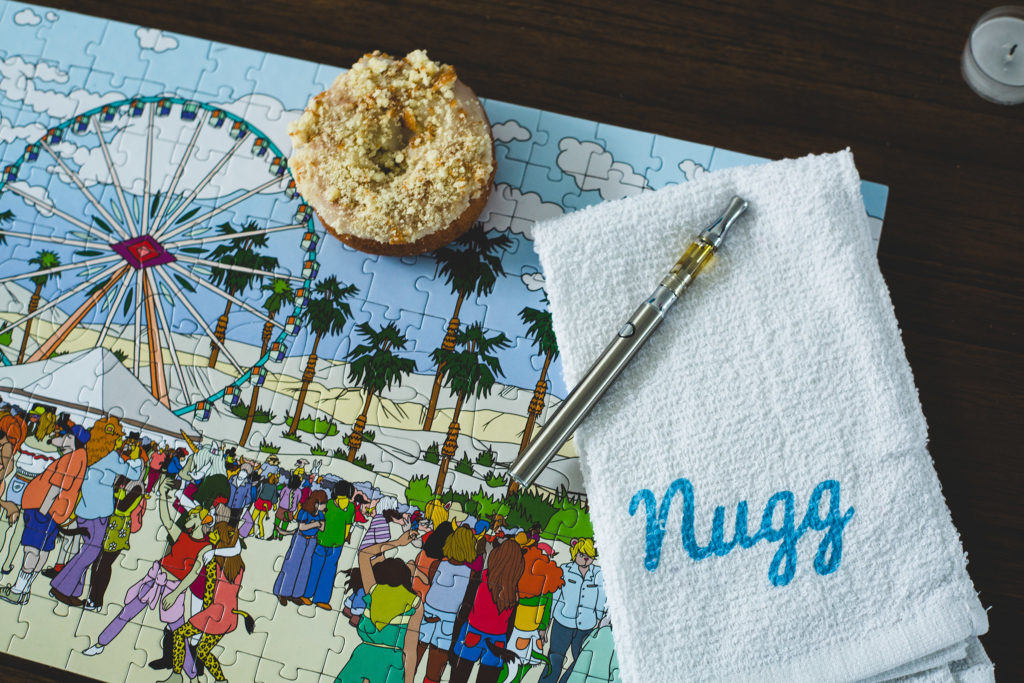What Is CBD?
If you’re just joining the class, let’s review the basics. CBD, AKA cannabidiol, is considered one of the core 483 compounds contained in the cannabis plant. While it doesn’t make you high alone, it does induce a mild state of well being. Some other cannabinoids you might know are:
- THC (Tetrahydrocannabinol)
- THCA (Tetrahydrocannabinolic Acid)
- THCV (Tetrahydrocannabinol)
- CBC (Cannabichromene)
- CBN (Cannabinol)
- CBG (Cannabigerol)
- CBDV (Cannabidivarin)
Each of these distinct compounds is known for producing their own set of benefits and effects. However, cannabis is more than the sum of its separate components.
Isolates Vs. Whole Plant CBD
The cannabis compounds above are called isolates, substances that have been separated from their combined mixtures. Each isolate will have its own chemical properties and effects that are separate from the mixture they were derived from.
It’s difficult to overemphasize an important fact: these compounds can have completely different effects as isolates than they do when combined with each other.
THC alone has been proven to cause panic, anxiety and tachycardia (rapid heart rate) in some users. While this reaction isn’t fatal, it certainly interferes with the more pleasant side-effects of a high. The good news is that CBD can mitigate these negative effects.
This isn’t something to take lightly considering the plant’s medical applications. And there are more examples where this came from.
CBD More Beneficial Than THC?
Not at all. There’s an ongoing and incomprehensible myth that CBD is the good cannabinoid while THC is the bad one. Why? Probably because THC makes you high and CBD doesn’t. There’s a basic assumption behind this reasoning: things that make you feel good are bad for you. This couldn’t be more wrong.
Eating chocolate feels good; it has antioxidants, minerals and other nutrients that the body requires to maintain a healthy diet. Actually, eating anything tasty feels good. Why? The body creates reward pathways for survival so we’re more likely to do (and eat) things that are good for us.
The problem occurs when the triggering substance gets replaced with something harmful that carries the same feel-good effect. If naturally nutritious food gets replaced by processed junk, you’ll get sick—even if it feels good.
Pleasure Isn’t the Problem
Take dopamine, the chemical released with “runners’ high,” laughing, and even sex—basically anything that’s awesome. Cocaine also releases dopamine; but while the previously listed activities that lead to its release are usually healthy, cocaine is not. What’s wrong here? We’ve replaced naturally healthy methods of dopamine release with a caustic chemical that causes irritation, bleeding, and tissue damage.
The problem isn’t the reward pathway—it’s the thing that causes a reward. If it’s bad for our health, it’s a problem; if it’s good, it’s a solution. So far, THC shows promise to unlock many health benefits. Is the fact that it makes us feel good a bad thing? Of course not!
Mother Nature Knows Best
There’s another misconception that any cannabinoid works just as well without the others. This isn’t just assumed for CBD. You’ll also find potent MMJ products that have very little CBD and up to 25% THC. This isn’t necessarily the natural form of the plant that we’re evolutionarily designed to absorb.
We actually have specific receptors designed to receive cannabinoids. We create our own endocannabinoids in our cells, which bind to these same receptors. Cannabinoids are the actual substances designed for that reward pathway. Many believe the best cannabinoid combinations are those in their natural form, not distilled and purified like a pharmaceutical.
Considering the emerging evidence, there might be a case for not disturbing Mother Nature. The whole plant, with all of its complementary compounds, was designed to work together both in nature and our bodies.
The Case for Only CBD
Still, there are reasons why you might want to take pure CBD. You may:
- Want to try it for anxiety if you don’t tolerate THC well.
- Live in a state that hasn’t legalized cannabis.
- Want to test cannabis’ health benefits but get drug tested at work.
A CBD-only formula helps at least derive some benefit from cannabis, even though you can’t enjoy the full plant. Hopefully, in the future, the law won’t block anyone from enjoying the benefits of whole-plant, CBD-rich cannabis extracts.
Can CBD Convert to THC in My Body?
There’s a myth that CBD can convert to THC in our digestive systems, which is untrue. The rumor originates from a 1940s study that tested conversion rates in prolonged exposure to artificial stomach acids.
It’d take an enormous amount of CBD to end up with detectable amounts of THC in your bloodstream. Estimates are that roughly 1% to 3% of the amount of CBD ingested is converted to, and excreted out, as ∆9 and ∆8 THC.
Consider Your CBD Source
Lots of companies extract their oil from industrial hemp. It’s a little hard to believe they can extract an efficient amount of CBD from non-flowering hemp since CBD oil is mostly extracted from the cannabis plant’s resinous, flowering tops and leaves.
Other companies are going even further by extracting CBD oil from hemp seeds. While hemp seeds and hemp seed oil are wonderful sources of nutrition, they aren’t usable CBD sources as they don’t produce cannabinoids.
Another risk factor? Since so much industrial hemp is required to extract a tiny amount of CBD, contamination risk increases. If grown in a tainted area, hemp could produce polluted oil as it’s a notoriously powerful bio-accumulator. Those toxins hemp cleans from the soil have to go somewhere, and they go into the plant. So it’s better to use fewer and more resinous plants to reduce environmental toxins in the resulting oil.
What to Look for in CBD Products
The best CBD oil is produced using high-CBD plants with a high resin level, not industrial hemp. Many cultivators breed plants to be high CBD and low THC, less than .03%. These strains are proving to be a powerful treatment against Dravet’s Syndrome and other forms of epilepsy.
Just don’t forget: THC is medicine too. If you live in a legal state and work for a company that doesn’t test for THC, consider the benefits of using whole-plant, high CBD products with a complete cannabinoid profile.
Now that you know the good and bad about CBD, here are the most common ways to ingest it. Remember, always ask your doctor about the best delivery method and how much to take before medicating.
Edibles & Drinkables
There are just as many ways to eat CBD oil as there are ways to ingest THC. CBD oil is used in exactly the same way. And as the plant’s popularity continues to rise, we’re beginning to see CBDs featured at mainstream restaurants and health food stores. One of the most beautiful examples of creative consumption is the Mr. Nice Guy cocktail at San Diego’s Madison on Park.
Since you’re probably taking CBD oil for its health benefits, consider the vehicle you’re putting it in/on CBD gummies are cute and tasty, but also chock full of sugar. Instead, combine your favorite fruits with kale, chia seeds, yogurt or oats in a power smoothie and add a few drops of CBD oil to feel like a true superhero.
Potential Benefits
A CBD edible or drinkable may be a way to counteract an overactive high, since a solid dose of CBD has been shown to help calm anxiety and soothe inflammation.
And speaking of inflammation, several current studies explore the benefits of cannabinoids to soothe intestinal inflammation, Crohn’s, IBS, and other stomach related illnesses. The GI tract is lined with receptors that snatch up CBDs for these anti-inflammatory benefits. In other words, this might be the best and most effective delivery method for these conditions.
Potential Disadvantages
Make sure you have a clean source of CBD oil. As mentioned, cannabis can pull lots of toxins and pesticides from the soil. Other than this, there aren’t any know dangers; you won’t get high and you won’t overdose. Of course, read the package and make sure you’re not about to chow down on a product that contains CBD and high amounts of THC—unless you really want to.
How Much Should I Take?
It isn’t legal to list a recommended amount of CBD since the FDA reserves the right to set guidelines for nutrients. Until then, you should follow the dosage others are doing. If you are taking CBD only, typical doses are anywhere from 3mg per serving to 1,000mg per serving.
Start at a small amount, just a few milligrams, and gradually work up to the right dose for you. Everyone has different needs so most people experiment with different CBD to THC ratios and/or other cannabinoids as well.
A word of caution. If you’ve never eaten THC—even though you’ve smoked it—do not start with a high CBD/THC product. Most novices start with 5-10mg and usually feel medicated for hours. Can you imagine accidentally eating a 1,000mg brownie because you thought it was only CBD? You wouldn’t die, but it’d take a couple days to peel yourself off the walls.
It wouldn’t matter if the product had a balanced THC and CBD ratio either; no amount of CBD can counteract a dose that high. So while you freely experiment with your CBD dosage, approach any accompanying THC with extreme caution.
Sublinguals
Sometimes, under the tongue delivery is the most efficient way to take a medicine. That’s why nitroglycerin is placed under the tongue, instead of swallowed when a heart attack is near.
How does it work? The thin membrane of epithelium under the tongue is filled with large, absorbent blood vessels. When an herb absorbs into these blood vessels, it allows their compounds to pass directly into the bloodstream instead of first passing through the digestive tract.
How It’s Done
Simply place the recommended amount under your tongue and hold it there for a couple of minutes, then swallow.
Potential Benefits
Much faster delivery of its beneficial effects. If you’re using the CBDs for pain, headaches, seizures or other problems that need quick relief, many swear by this method.
Potential Disadvantages
Sometimes, you want to deliver the medicine to your digestive system first. If you are using CBD to help a rumbly tummy, intestinal distress, or liver problems, then you might be better off with an edible than sublingual delivery.
Topicals
This is a great way to take CBDs for skin problems or sore muscles. Many patients swear by CBD lotions, rubs, salves and oils for muscle pain.
How It’s Done
Just rub your CBD lotion onto your achy, itchy or splotchy parts.
Potential Benefits
Might be the best delivery method for skin conditions.
Potential Disadvantages
May not provide as potent a form of relieve as edible administration or tinctures.
A word of caution. Most say it’s impossible to absorb enough THC through your skin to fail a drug test or get high. Maybe. Most topicals just don’t have enough THC to matter. However, a tiny amount can absorb through the skin and make you high if you use enough, though it’d require more than an impractical amount.
Some theorize that many historical figures anointed themselves with cannabis oil to become high during rituals and thus commune with nature, God, etc. Likely, if they were only anointing and not smoking, they just had really soft skin.
Still, it’s better to be safe than sorry. Wait several hours and only increase the amount gradually if you’re concerned about the effects. If you choose one of those lotions with both CBD and THC (not THCA), make sure to start small and see how it affects you first. Non-decarboxylated (not heated) THCA is the precursor to THC and considered to be non-psychoactive until it’s heated.
Vaporizers
Vaping, like smoking, is one of the fastest, most potent delivery systems available. It also lasts the shortest amount of time, so the doses have to be repeated several times a day.
How It’s Done
Special cartridges of liquid cannabis extract are connected to a battery and heated until the liquid is vaporized and inhaled.
Potential Benefits
This is a convenient and unobtrusive way to inhale cannabis without the tell-tale smell. It also doesn’t expose your lungs to the tar associated with smoking dabs or flower, so some people (not all) find it to be less irritating.
Potential Disadvantages
There’s a tradeoff between vaping and smoking. Oddly, people used to consider limited smoking a healthy activity because they believed it would ward off parasites and disease. But now we realize the last thing our lungs need is a daily coating of fresh tar. So, we’ve begun to vape more often for both health benefits and the convenience.
It’s important to remember the law of unintended consequences. We haven’t been vaping long enough to understand the long-term health consequences. Additionally, many alarming safety concerns have popped up in recent months. Recently, the concentrates used in Brass Knuckles vape cartridges failed lab tests for pesticide exposure. One of the most alarming pesticides, Eagle 20, turns into cyanide when smoked—and that’s just one of the nasty pollutants they found.
If you’re vaping CBD-only cartridges for the “health benefits without the high” you could potentially be breathing in pesticides as well. Worse, some of the hemp-only CBD cartridges are sold without the same level of testing required for THC cartridges. Worst of all, many vape cartridges use propylene glycol to water down the oil into something that is easily vaped. This can irritate the lungs and there isn’t enough info about long-term consumption to ensure safety.
Yet this isn’t to say that vaping is a bad choice. It’s just a warning to consider your source carefully. Your best bet for the best benefit is to purchase fully lab-tested cartridges that don’t contain propylene glycol.
If you want to find the best CBD products, use Nugg’s cannabis delivery platform to find and have them brought to you! Unsure where to start? Consult our live chat cannabis experts who’ll help you find the best consumption method(s), dosage and lab-approved CBD products to ensure the best experience possible.
California Lawmakers Drop Zero-Tolerance Proposal for Young Motorists
Leave a Comment
This excerpt is taken from “The Shake,” Nugg’s dedicated cannabis industry news dispatch. Covering issues at the local, national, and international level, you’ll have it sent directly to your inbox. Want in? Click here to sign-up.











